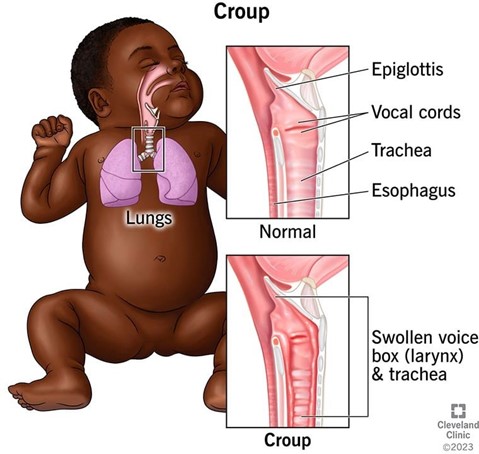In assessing a 2-year-old boy with croup, the practical nurse (PN) finds that he has become increasingly irritable and has developed tachypnea and resting stridor. Which intervention is best for the PN to implement?
Instruct the mother to play with the child for stimulation and distraction.
Administer a dose of acetaminophen as needed.
Monitor the child's oxygen saturation level via pulse oximetry.
Encourage the child to drink adequate amounts of fluids.
The Correct Answer is C
Croup is a respiratory infection that causes inflammation and narrowing of the airway, resulting in a barking cough, hoarseness, and stridor. The PN should monitor the child's oxygen saturation level via pulse oximetry, as it can indicate the severity of the airway obstruction and the need for supplemental oxygen or other interventions.

The other options are not correct because:
A. Instructing the mother to play with the child for stimulation and distraction may worsen the child's condition, as it can increase his respiratory demand and anxiety.
B. Administering a dose of acetaminophen as needed may help reduce fever or pain, but it does not address the underlying cause of croup or improve airway patency.
D. Encouraging the child to drink adequate amounts of fluids may help prevent dehydration and thin the secretions, but it does not relieve the inflammation or narrowing of the airway.
Nursing Test Bank
Naxlex Comprehensive Predictor Exams
Related Questions
Correct Answer is A
Explanation
The correct answer is choice A: Have the client sit down in the hall.
Choice A rationale: The PN should first have the client sit down to help alleviate the client's chest tightness and shortness of breath. Sitting down allows for better lung expansion and reduces the risk of falling due to dizziness or lightheadedness. This is the most appropriate initial action in response to the client's complaint.
Choice B rationale: While assisting the client back to their room is important, the PN should first ensure that the client is sitting down to help manage their symptoms. After the client is seated and more stable, the PN can then assist them back to their room for further assessment and intervention.
Choice C rationale: Administering sublingual nitroglycerin may be appropriate if the client is experiencing cardiac-related chest pain. However, the PN should first have the client sit down and gather more information about their symptoms before administering any medications.
Choice D rationale: Obtaining a 12-lead electrocardiogram can help assess the client's cardiac status, but it is not the first action that the PN should take in this situation. Ensuring the client's safety and managing their symptoms are immediate priorities. The PN can consider obtaining an electrocardiogram after addressing the client's immediate needs and assessing their condition further.
Correct Answer is A
Explanation
The correct answer is Choice A:
Assist in turning the client to one side. Choice A rationale:
When preparing a client with obstructive sleep apnea for sleep, the practical nurse (PN) should assist the client in turning to one side. This position is known as the lateral position and can be beneficial for clients with obstructive sleep apnea. Lying on one's side can help to reduce the likelihood of airway obstruction and minimize the occurrence of apnea (pauses in breathing) during sleep. This position promotes better airflow and can improve the client's overall sleep quality.
Choice B rationale:
Keeping oral suction equipment nearby (Choice B) might be appropriate for clients with respiratory issues or a risk of airway obstruction. However, it is not the best action for a client with obstructive sleep apnea. Sleep apnea primarily involves upper airway collapse, not excessive secretions or obstructions in the oral cavity.
Choice C rationale:
Offering to bring the client a sleeping pill (Choice C) is not an appropriate action for a client with obstructive sleep apnea. Sleep apnea is characterized by repeated episodes of blocked or restricted airflow during sleep. Sedative medications can further relax the muscles in the airway, worsening the condition and potentially leading to more severe apnea.
Choice D rationale:
Placing a cool air humidifier in the room (Choice D) may be helpful for clients who experience dryness or congestion in the airways during sleep. However, it is not specifically indicated for obstructive sleep apnea. While humidifiers can be beneficial for some sleep-related issues, they do not address the underlying cause of sleep apnea.
Whether you are a student looking to ace your exams or a practicing nurse seeking to enhance your expertise , our nursing education contents will empower you with the confidence and competence to make a difference in the lives of patients and become a respected leader in the healthcare field.
Visit Naxlex, invest in your future and unlock endless possibilities with our unparalleled nursing education contents today
Report Wrong Answer on the Current Question
Do you disagree with the answer? If yes, what is your expected answer? Explain.
Kindly be descriptive with the issue you are facing.
